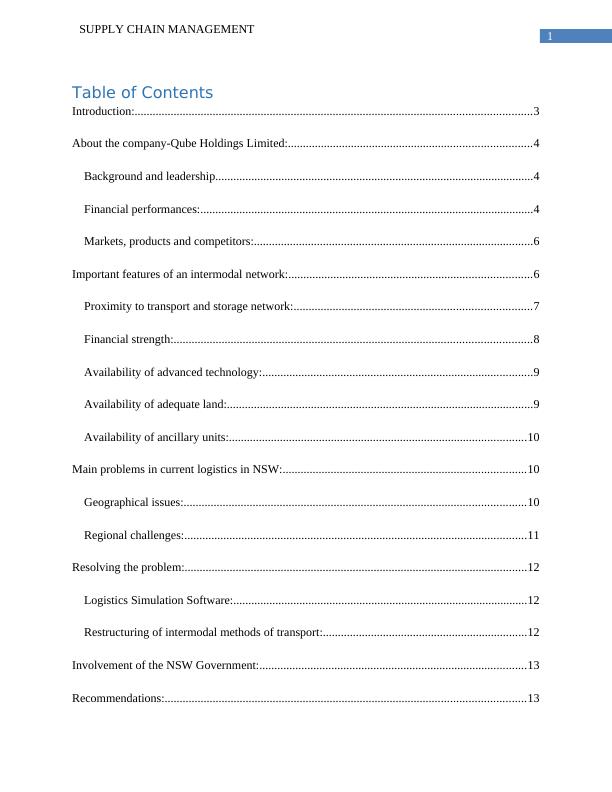Intermodal and Supply Chain Management
Added on 2023-04-23
20 Pages4085 Words315 Views
Running head: SUPPLY CHAIN MANAGEMENT
Intermodal and Supply Chain Management
Name of the Student
Name of the University
Author note
Intermodal and Supply Chain Management
Name of the Student
Name of the University
Author note

1
SUPPLY CHAIN MANAGEMENT
Table of Contents
Introduction:....................................................................................................................................3
About the company-Qube Holdings Limited:.................................................................................4
Background and leadership..........................................................................................................4
Financial performances:...............................................................................................................4
Markets, products and competitors:.............................................................................................6
Important features of an intermodal network:.................................................................................6
Proximity to transport and storage network:...............................................................................7
Financial strength:.......................................................................................................................8
Availability of advanced technology:..........................................................................................9
Availability of adequate land:......................................................................................................9
Availability of ancillary units:...................................................................................................10
Main problems in current logistics in NSW:.................................................................................10
Geographical issues:..................................................................................................................10
Regional challenges:..................................................................................................................11
Resolving the problem:..................................................................................................................12
Logistics Simulation Software:..................................................................................................12
Restructuring of intermodal methods of transport:....................................................................12
Involvement of the NSW Government:.........................................................................................13
Recommendations:........................................................................................................................13
SUPPLY CHAIN MANAGEMENT
Table of Contents
Introduction:....................................................................................................................................3
About the company-Qube Holdings Limited:.................................................................................4
Background and leadership..........................................................................................................4
Financial performances:...............................................................................................................4
Markets, products and competitors:.............................................................................................6
Important features of an intermodal network:.................................................................................6
Proximity to transport and storage network:...............................................................................7
Financial strength:.......................................................................................................................8
Availability of advanced technology:..........................................................................................9
Availability of adequate land:......................................................................................................9
Availability of ancillary units:...................................................................................................10
Main problems in current logistics in NSW:.................................................................................10
Geographical issues:..................................................................................................................10
Regional challenges:..................................................................................................................11
Resolving the problem:..................................................................................................................12
Logistics Simulation Software:..................................................................................................12
Restructuring of intermodal methods of transport:....................................................................12
Involvement of the NSW Government:.........................................................................................13
Recommendations:........................................................................................................................13

2
SUPPLY CHAIN MANAGEMENT
Measuring carbon footprint:......................................................................................................13
Supply chain redesigning:..........................................................................................................14
Conclusion:....................................................................................................................................15
References:....................................................................................................................................16
SUPPLY CHAIN MANAGEMENT
Measuring carbon footprint:......................................................................................................13
Supply chain redesigning:..........................................................................................................14
Conclusion:....................................................................................................................................15
References:....................................................................................................................................16

3
SUPPLY CHAIN MANAGEMENT
Introduction:
The intermodal mode of goods transport plays a very significant role in making inventory
of raw materials, work-in-progress and finished goods available in the market. Qu, Bektaş and
Bennell (2016) define the term intermodal transport is the method of transporting goods freight
from place to another without physically handling the goods being transported. The term
intermodal transport can also be defined according the lines of Bilgen (2016) as the
transportation of goods using multiple modes of transport which includes ships and trucks. An
analysis of the two definition brings into light two aspects of the term. The first aspect is that the
goods being transported are not handled physically and the second aspect is that multiple modes
of transport are involved in intermodal network. Intermodal transport increases the security and
reduces scopes of spillage or loss of goods owing to the fact that the goods being packed are not
dismantled, only the container holding the goods are unloaded and loaded (Xu, Cheng and
Huang 2015). Secondly, the intermodal network enables transportation of bulk goods across long
distances, thus reducing per unit transportation costs. Thirdly, the intermodal transport relieves
the companies of high insurance costs since the containers are only handled. Fourthly,
intermodal transport enables bulk goods, thus enabling companies to reduce their carbon
footprints while transportation of goods. These advantages of intermodal network have made
them very significant to national economies and organisations at the micro-economic levels are
considering intermodal transportation with due importance and embracing a service-centric
business model rather than considering their manufacturing activities are pivotal activities. It can
be stated that companies are considering offering services to customers as important as selling
goods. This growing importance of services in the manufacturing sector has led to coining of the
term ‘service science’ and manufacturing companies are also providing services to customers
SUPPLY CHAIN MANAGEMENT
Introduction:
The intermodal mode of goods transport plays a very significant role in making inventory
of raw materials, work-in-progress and finished goods available in the market. Qu, Bektaş and
Bennell (2016) define the term intermodal transport is the method of transporting goods freight
from place to another without physically handling the goods being transported. The term
intermodal transport can also be defined according the lines of Bilgen (2016) as the
transportation of goods using multiple modes of transport which includes ships and trucks. An
analysis of the two definition brings into light two aspects of the term. The first aspect is that the
goods being transported are not handled physically and the second aspect is that multiple modes
of transport are involved in intermodal network. Intermodal transport increases the security and
reduces scopes of spillage or loss of goods owing to the fact that the goods being packed are not
dismantled, only the container holding the goods are unloaded and loaded (Xu, Cheng and
Huang 2015). Secondly, the intermodal network enables transportation of bulk goods across long
distances, thus reducing per unit transportation costs. Thirdly, the intermodal transport relieves
the companies of high insurance costs since the containers are only handled. Fourthly,
intermodal transport enables bulk goods, thus enabling companies to reduce their carbon
footprints while transportation of goods. These advantages of intermodal network have made
them very significant to national economies and organisations at the micro-economic levels are
considering intermodal transportation with due importance and embracing a service-centric
business model rather than considering their manufacturing activities are pivotal activities. It can
be stated that companies are considering offering services to customers as important as selling
goods. This growing importance of services in the manufacturing sector has led to coining of the
term ‘service science’ and manufacturing companies are also providing services to customers

End of preview
Want to access all the pages? Upload your documents or become a member.
Related Documents
Logistics Management Reportlg...
|16
|3414
|53
Intermodal Transportation and Logistics Management Strategies: A Case Study of Pakistan Intermodal Limitedlg...
|13
|3785
|103
International Intermodals - Qube Logisticslg...
|15
|3736
|48
Logistics and Supply Chain Management - Characteristics of an Intermodal Company and Solutions to Associated Problemslg...
|13
|4057
|178
Intermodal Benefits and Featureslg...
|13
|3145
|214
LOGISTICS MANAGEMENT.lg...
|15
|3453
|129
